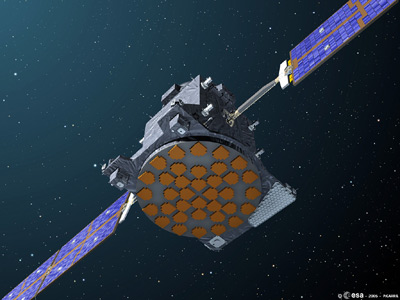
GIOVE
Jump to: Mission Objectives, Mission Instrumentation, Mission Parameters, Additional Information
Mission Photos:
 |
 |
| GIOVE-A (Courtesy of ESA) | GIOVE-B (Courtesy of ESA) |
Mission Objectives:
Galileo is a satellite radio navigation system initiative launched by the European Union and the European Space Agency. Galileo consists of a constellation of 30 satellites and ground stations providing position information to users in many sectors (transportation, social services, justice system, custom services, public works, search and rescue, etc.).
Two experimental spacecraft were launched in 2005 and 2008 as part of the Galileo System Test Bed V2: GIOVE-A (Galileo In-Orbit Validation Element, formerly GSTB-V2/A) and GIOVE-B (formerly GSTB-V2/B). The objectives of this mission are:
- to secure the Galileo frequency allocations by providing a signal in space
- on-board clock characterization
- MEO radiation environment characterization
- additional experimentation
The GIOVE-A and -B satellites are equipped with LLR arrays to provide precise orbit determination. Both routine SLR tracking and occasional campaigns with more intense tracking will be required. By June 2006, a sufficient number of receivers were deployed to allow ESA to begin microwave orbit determination. Therefore, an initial SLR tracking campaign began in June 2006 and lasted for eight weeks; further campaigns followed with routine tracking currently in place. Predictions are based on these microwave-determined orbits; prediction accuracy is on the order of 30 meters. GIOVE-A tracking is comparable to GLONASS and GPS tracking (perhaps up to 40 percent more return energy than GPS).
A third satellite, GIOVE-A2, is under construction in 2007 for launch in the second half of 2008. The same company that built GIOVE-A will build this new satellite, basing its technology on that of GIOVE-A, with some enhancements.
Mission Instrumentation:
GIOVE-A has the following instrumentation onboard:
- Phased array antenna of individual L-band elements
- Signal generation units to create two representative Galileo signals
- Two redundant rubidium atomic clock
- Retroreflector array
Mission Parameters:
| GIOVE-A (GSTB-V2/A) | GIOVE-A2 | GIOVE-B (GSTB-V2/B) | Galileo | |
| Sponsor: | EU/ESA | EU/ESA | EU/ESA | EU/ESA |
| Expected Life: | 2 years | 2 years | 2 years | years |
| Primary Applications: | Positioning | Positioning | Positioning | Positioning |
| COSPAR ID: | 0505101 | TBD | 0802001 | TBD |
| SIC Code: | 7001 | TBD | 7002 | TBD |
| Satellite Catalog (NORAD) Number: | 28922 | TBD | 32781 | TBD |
| Launch Date: | 26-Dec-2005 | Mid 2008 | 26-Apr-2008 | 2009 |
| RRA Size: | 308mm x 408mm x 48 mm | 308mm x 408mm x 48 mm | 305mm x 305mm x 42 mm | 435mm x 540mm x 53mm |
| RRA Shape: | trapezoidal | trapezoidal | trapezoidal | trapezoidal |
| Reflectors: | 76 corner cubes | 76 corner cubes | 67 corner cubes | 78 corner cubes |
| Size of Reflector: | 27 mm | 27 mm | 27 mm | 27 mm |
| Orbit: | near-circular | near-circular | near-circular | near-circular |
| Inclination: | 56 degrees | 56 degrees | 56 degrees | 56 degrees |
| Altitude: | 23,916 km | 23,916 km | 23,916 km | 23,916 km |
| Eccentricity: | 0.002 | 0.002 | 0.002 | 0.002 |
Additional Information:
Web sites:
- ESA GIOVE Home Page
- ESA GIOVE Conference Papers
- ESA Galileo Home Page
- ESA Galileo First Launch
- ESA Galileo Home Page
- European Union Galileo Home Page
- European GNSS Agency
- Inside GNSS Galileo section
Publications:
- "GIOVE Experimentation Results: a Success Story", ESA publication, October 2011.
- Appleby, G. and Gibbs, P. "First Laser Range Measurements to GIOVE-A", Inside GNSS, May/June 2006.
- Falcone, M., Navarro-Reyes, D., Hahn, J., Otten, M., Piriz, R., Pearlman, M. "GIOVE's Track", GPS World, November 2006. (PDF version)
- Schoenemann, E., Springer, T.A., Otten, M., Becker, M., Dow, J., "GIOVE-A Precise Orbit Determination from Microwave and Satellite Laser Ranging Data - First Perspectives for the Galileo Constellation and Its Scientific Use" (PDF paper | presentation), at Scientific and Fundamental Aspects of the Galileo Programme, Toulouse, France, October 2007.
- Hidalgo, I. et al, "Estimation and Prediction of the GIOVE Clocks", 40th Annual Precise Time and Time Interval (PTTI) Meeting, Reston, VA, December 2008.




